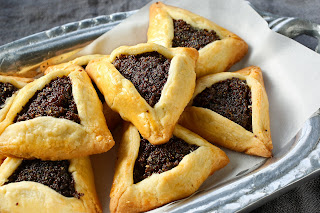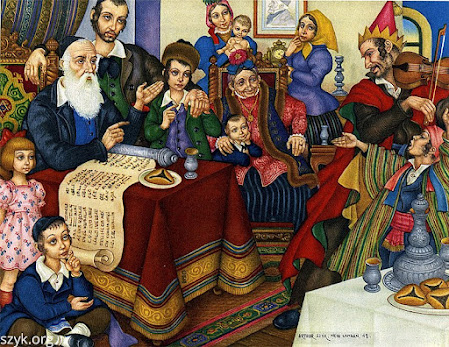One of the most difficult things for us today is to understand and appreciate the rule of the Mishkan, the holy tabernacle that contained the ark of the covenant and the mysterious cherubs that were placed on top of it. In the following piece, our member Rabbi Paul Bloom tackles the topic:
The Mishkan: A Sanctuary of Divine Connection and Symbolism.
וְעָ֥שׂוּ לִ֖י מִקְדָּ֑שׁ וְשָׁכַנְתִּ֖י בְּתוֹכָֽם׃
And let them make Me a sanctuary that
I may dwell among them.
With
just five words, the Torah introduces us to a transformative era in the life of
Klal Yisrael. Having journeyed through the experiences of Yetziat Mitzrayim,
Matan Torah, the miracles, and the revelation of Hashem, Bnei Yisrael are now
called upon to undertake a collective project—the construction of the Mishkan.
This was no ordinary building; every detail was imbued with profound spiritual
significance.
The Divine Wisdom in the
Mishkan
The
Talmud (Berachot 55a) teaches us about the extraordinary wisdom of Bezalel, the
chief artisan of the Mishkan. Chazal explain that Hashem created the world
through the letters of the Aleph-Bet, and Bezalel was granted the unique
insight to understand these divine forces. Rashi expounds that Bezalel
possessed Chochmah, Binah, and Da’at—Ruach Hakodesh—a sacred knowledge that enabled him to
construct the Mishkan as a microcosm of the universe. Just as the physical
world was created to manifest Hashem’s presence, the Mishkan served as a
concentrated space for sanctity, permeating all aspects of existence with kedushah.
The Aron HaKodesh: The
Heart of the Mishkan
At
the very core of the Mishkan stood the Aron HaKodesh, a sealed sacred ark
housing the Luchot HaBrit—the tablets Moshe received at Har Sinai. The
Aron was hidden away in the Kodesh HaKodashim, accessible only once a
year on Yom Kippur by the Kohen Gadol. Despite its physical concealment, the
Aron served as the spiritual epicenter of the Mishkan, radiating kedushah
throughout.
The construction of the Mishkan and later
the Beit HaMikdash stands at the center of Jewish history and law. The Rambam,
in Hilchot Beit HaBechirah (Chapter 1), counts the mitzvah of building
the Beit HaMikdash as one of the 613 commandments. Every generation is bound by
this commandment, though not every era has been capable of fulfilling it. From
Shlomo HaMelech’s construction of the first Beit HaMikdash to Ezra’s leadership
in building the second, each iteration of this sacred structure fulfilled a
divine directive—to establish a spiritual epicenter for Klal Yisrael.
The Gold Within and
Without
The Torah specifies that the Aron was
made of wood, overlaid with gold inside and out (Shemot 25:11). The Gemara in
Yoma 72b extracts a vital lesson from this detail: one who represents Torah
must be “tocho kebaro”—their inner self must match their outer persona.
True Torah scholars must live lives of authenticity and integrity, embodying
the values they espouse. The Rambam in Hilchot De’ot (Chapter 2) extends
this idea, prohibiting deceitful behavior and emphasizing the necessity of
inner and outer consistency in one’s character.
Additionally, the combination of wood and
gold itself holds meaning. Wood symbolizes growth and adaptability, while gold
represents stability and permanence. The interplay between these materials
mirrors the dual nature of Torah and halacha—immutable principles that must be
applied with wisdom and sensitivity to the evolving needs of each generation.
Rav Kook encapsulated this idea in his axiom, HaYashan Yischadesh v’HaChadash Yiskadesh—the ancient must be
revitalized, and the new must be sanctified. The eternal truths of Torah must
be dynamically applied to the realities of contemporary Jewish life.
The Permanence of the
Poles
One of the unique aspects of the Aron was
that its carrying poles were never to be removed (Shemot 25:15). Unlike the
other vessels of the Mishkan, which had removable poles for transport, the
Aron’s poles remained fixed even after the Beit HaMikdash was established. This
detail carries deep significance.
- The Mobility of Torah – Rav Hirsch explains that the fixed poles symbolize the
universal and portable nature of Torah. While the Menorah, Mizbe’ach,
and Shulchan were rooted in the Beit HaMikdash, the Torah is not
confined to any one place; it travels with Klal Yisrael throughout history
and across all lands.
- Supporters of Torah – The
Chatam Sofer interprets the poles as representing the machzikei haTorah—those who support Torah learning. Just as
the Aron itself housed the Luchot, symbolizing the scholars who
dedicate their lives to Torah, the poles represent the benefactors who
enable its continuity. Their attachment to Torah is eternal, ensuring its
transmission across generations.
- The Aron Carries Its
Bearers – A remarkable idea found in Sotah 35a
teaches that the Aron was noso et
nosov—it carried those who carried it. This profound notion
underscores that those who dedicate themselves to Torah, whether through
study or support, are ultimately upheld by it. Torah does not merely
demand effort; it sustains and elevates those who cleave to it.
Rabbi Jonathan Sacks ztz”l once
illustrated this idea poignantly. At the conclusion of his tenure as Chief
Rabbi of the UK, he was presented with a Sefer Torah as a parting gift. In his
emotional response, he remarked, “You may think you see me carrying this Torah,
but the truth is, it is carrying me.” This encapsulates the eternal truth of
Klal Yisrael’s survival—the Torah is our foundation, our guide, and our
sustainer.
The Mystery of the Keruvim
On
the lid of the Aron were the two keruvim (cherubs). This is what the Torah says of
them:
וְעָשִׂ֛יתָ שְׁנַ֥יִם כְּרֻבִ֖ים זָהָ֑ב מִקְשָׁה֙ תַּעֲשֶׂ֣ה אֹתָ֔ם מִשְּׁנֵ֖י קְצ֥וֹת הַכַּפֹּֽרֶת׃
Make
two cherubim of gold—make them of hammered work—at the two ends of the cover.
וַ֠עֲשֵׂ֠ה כְּר֨וּב אֶחָ֤ד מִקָּצָה֙ מִזֶּ֔ה וּכְרוּב־אֶחָ֥ד מִקָּצָ֖ה מִזֶּ֑ה מִן־הַכַּפֹּ֛רֶת תַּעֲשׂ֥וּ אֶת־הַכְּרֻבִ֖ים עַל־שְׁנֵ֥י קְצוֹתָֽיו׃
Make
one cherub at one end and the other cherub at the other end; of one piece with
the cover shall you make the cherubim at its two ends.
וְהָי֣וּ הַכְּרֻבִים֩ פֹּרְשֵׂ֨י כְנָפַ֜יִם לְמַ֗עְלָה סֹכְכִ֤ים בְּכַנְפֵיהֶם֙ עַל־הַכַּפֹּ֔רֶת וּפְנֵיהֶ֖ם אִ֣ישׁ אֶל־אָחִ֑יו אֶ֨ל־הַכַּפֹּ֔רֶת יִהְי֖וּ פְּנֵ֥י הַכְּרֻבִֽים׃
The
cherubim shall have their wings spread out above, shielding the cover with
their wings. They shall confront each other, the faces of the cherubim being
turned toward the cover.
וְנָתַתָּ֧ אֶת־הַכַּפֹּ֛רֶת עַל־הָאָרֹ֖ן מִלְמָ֑עְלָה וְאֶל־הָ֣אָרֹ֔ן תִּתֵּן֙ אֶת־הָ֣עֵדֻ֔ת אֲשֶׁ֥ר אֶתֵּ֖ן אֵלֶֽיךָ׃
Place
the cover on top of the Ark, after depositing inside the Ark the Pact that I
will give you.
וְנוֹעַדְתִּ֣י לְךָ֮ שָׁם֒ וְדִבַּרְתִּ֨י אִתְּךָ֜ מֵעַ֣ל הַכַּפֹּ֗רֶת מִבֵּין֙ שְׁנֵ֣י הַכְּרֻבִ֔ים אֲשֶׁ֖ר עַל־אֲר֣וֹן הָעֵדֻ֑ת אֵ֣ת כׇּל־אֲשֶׁ֧ר אֲצַוֶּ֛ה אוֹתְךָ֖ אֶל־בְּנֵ֥י יִשְׂרָאֵֽל׃
There
I will meet with you, and I will impart to you—from above the cover, from
between the two cherubim that are on top of the Ark of the Pact—all that I will
command you concerning the Israelite people.
One
of the most enigmatic elements of the Aron was the presence of the Keruvim—two
golden, cherubic figures mounted atop the Aron’s cover. The Torah describes
them as having wings that stretched upwards toward Hashem while their faces
turned toward each other and downward toward the Luchot. This imagery carries
deep symbolic meaning.
The
placement of the Keruvim raises a fundamental question: How could the
Torah, which explicitly forbids the crafting of graven images (Second
Commandment), instruct the creation of these sculpted figures? The Chizkuni
offers an intriguing explanation. The Mishkan, and later the Beit HaMikdash,
existed in a different spiritual dimension—a sanctified realm where certain
prohibitions, such as melachah on Shabbat (there was baking,
slaughtering, lighting the menorah) and sha’atnez in the Kohanim’s
garments, were suspended. In this space, even the prohibition against graven
images did not apply.
The Meaning Behind the Keruvim
Many
commentators offer profound insights into the symbolism of the Keruvim:
- Rav Samson Raphael Hirsch: The two Keruvim
represent the dual dimensions of Torah observance—mitzvot bein adam laMakom (between man and God) and mitzvot bein adam lechavero
(between man and fellow man (chesed, tzedakah). Their facing
position signifies that these two aspects must be integrated for a
complete Torah life. That is the spiritual and generosity of Torah: emunah
and chesed
- Ba’al
HaTurim, based on Pirkei D’Rebbe Eliezer: The Keruvim symbolize
the dynamic nature of Torah study. They face each other, mirroring the way
Torah scholars engage in dialogue, sharpening their understanding through
Torah discussion. The Torah is not just a written text (Torah She’bichtav) housed within
the Aron, but also a living, ever-expanding oral tradition (Torah Sheba’al Peh), embodied in
the Keruvim’s interaction.
- The Ba’al Shem Tov and Chassidic Thought: The Keruvim
reflect three fundamental loves—Ahavat
Hashem (love of God), Ahavat
Yisrael (love of the Jewish people), and Ahavat HaTorah (love of Torah). The Keruvim’s wings
pointed heavenward, symbolizing our yearning for closeness to Hashem.
Their faces turned toward each other, representing the deep connection
between fellow Jews. Their gaze also directed toward the Luchot,
emphasizing the centrality of Torah in Jewish life.
The Mishkan as a Model
for the Future
Throughout
Bnei Yisrael’s forty years in the wilderness, Hashem’s voice would emanate from
between the Keruvim when communicating with Moshe Rabbeinu. This
reinforces the idea that the Mishkan was not merely a physical structure but a
space where divine presence, Torah, and love converged.
The
Mishkan teaches us that holiness is not confined to grandiose displays but is
found in the details—each aspect carrying divine intention. The construction of the Mishkan and the Beit HaMikdash was not merely
about creating a physical space for divine worship; it was about establishing a
perpetual source of inspiration for Am Yisrael. The Aron, with its inner and
outer gold, its blend of permanence and adaptability, and its permanently
affixed poles, embodies the eternal values of Torah—values that demand
integrity, support, and commitment. As we reflect on the meaning of the Aron
HaKodesh, we are reminded of our duty to live lives of authenticity, to
support and sustain Torah learning, and to recognize that ultimately, it is
Torah that carries us through the challenges and triumphs of Jewish history.
The
Keruvim symbolizes the integration of Torah observance, love for one another, and
a connection to Hashem which remains the cornerstone of Jewish life today.
May we all draw inspiration from the Mishkan’s
lessons, striving to bring sanctity into our own lives and communities.













